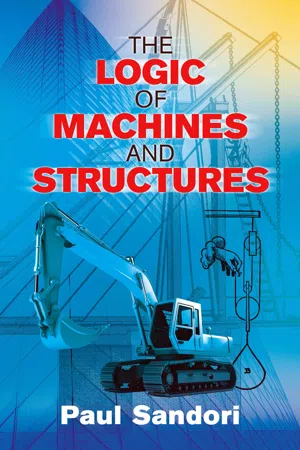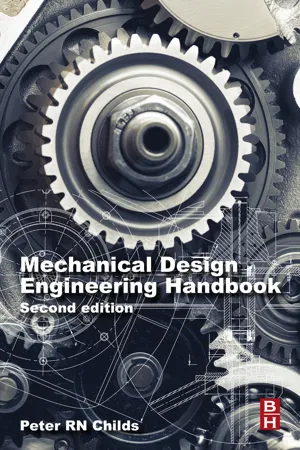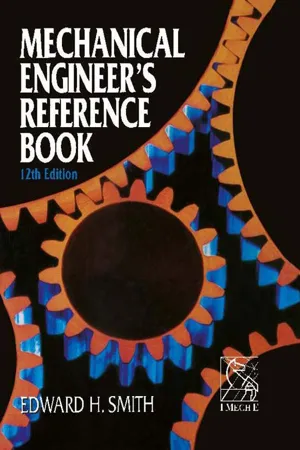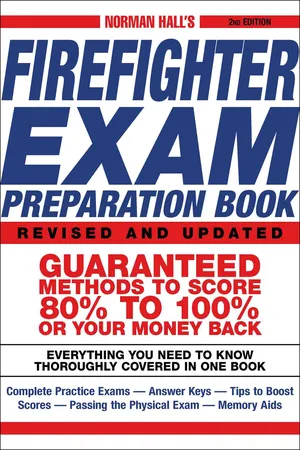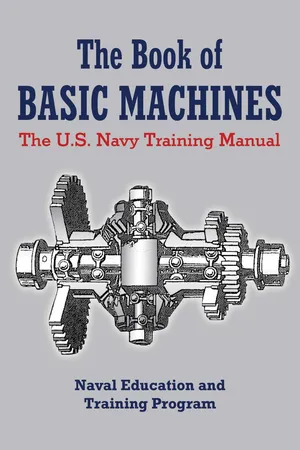Physics
Moments Levers and Gears
Moments, levers, and gears are fundamental concepts in physics that relate to the study of forces and motion. Moments refer to the turning effect of a force, levers are simple machines that amplify force or distance, and gears are mechanical devices that transmit motion and force. Understanding these concepts is crucial for analyzing the behavior of objects and systems in the physical world.
Written by Perlego with AI-assistance
Related key terms
Related key terms
1 of 4
Related key terms
1 of 3
5 Key excerpts on "Moments Levers and Gears"
- eBook - ePub
- Paul Sandori(Author)
- 2016(Publication Date)
- Dover Publications(Publisher)
For 2000 years since Archimedes all writers (including Stevin) belabored this inverse proportionality between forces and lever arms, for the simple reason that the branch of mathematics they were applying was geometry. That was also the only branch of mathematics sufficiently developed at the time. We now convert this ratio into a mathematically equivalent expression, more suited to modern algebra:The product (magnitude of force × lever arm) is called the moment of the force, or torque, and is a measure of its turning effect. The units of moment are those of force and length combined—newton-meters. The lever is balanced on the fulcrum when the moments of the two loads are equal and opposite: the clockwise moment of force B is balanced by the counterclockwise moment of force A. The two moments cancel each other out.Figure 2.10 A beam in equilibrium. The resultant moment of the forces is zero.The concept of moment, thus liberated from the lever where it originated, simplifies many things. For example, is the beam shown in Fig. 2.10 in equilibrium? There is no need to look for a lever to find out. The clockwise moments about the support at point T areThe counterclockwise moment is produced by a force of 24 newtons and is equal to the total clockwise moment:Therefore the beam is in equilibrium. The weight force acting on the beam at its center of gravity was not taken into account because it has no moment about the fulcrum T: the two points coincide and the lever arm of the force is zero.This can be refined further. Moments can turn the body on which they act either in a clockwise or in a counterclockwise sense. We distinguish between the two by giving a positive sign to clockwise moments and a negative sign to those acting in the opposite sense. Then we can add or subtract moments and express the law of the lever in yet another way. The sum total of the moments acting on a body is the resultant moment. The lever is balanced when the resultant moment about the fulcrum is zero. Thus in Fig. 2.10 we haveThe lever is in equilibrium. Suppose we add another 2 newtons to the force acting at point X - eBook - ePub
- Peter Childs(Author)
- 2018(Publication Date)
- Butterworth-Heinemann(Publisher)
20 Mechanisms Abstract The human race has been inventing and developing mechanisms for as long as our history indicates. The knowledge arising from the operation of these can be leveraged in designing variants, or developments, for modern applications. This chapter serves to introduce a range of mechanisms, some of which will have already been introduced or be familiar, in order to provide an indication of available designs and inspiration for the development of new ones. Keywords Machine; Gizmo; Gadget; Mechanism; Device; Invention; Mechanical Chapter Outline 20.1 Introduction 20.2 Levers 20.3 Pulleys 20.4 Linkages 20.5 Gears, belts and chains 20.6 Rotating and linear motion conversion 20.7 Brakes and clutches 20.8 Time metering 20.9 Miscellaneous devices 20.10 Conclusions References Websites Nomenclature Generally, preferred SI units have been stated. a length (m) c length (m) d pitch diameter (mm) F force (N) F applied applied force (N) F e effort (N) F load load (N) L length (m) m module (mm) M moment (N m) n rotational speed. (rpm) n arm rotational speed of arm (rpm) n sun rotational speed of sun gear (rpm) N number of teeth, number of discs N R number of teeth in ring gear N S number of teeth in sun gear p pressure (N/m 2) r radius (m) R radius (m) T torque (N m) μ coefficient of friction θ angle (rad) ω angular velocity (rad/s) 20.1 Introduction The human race has been inventing and developing mechanisms for as long as our history indicates. The knowledge arising from the operation of these can be leveraged in designing variants, or developments, for modern applications. This chapter serves to introduce a range of mechanisms, some of which will have already been introduced or be familiar, in order to provide an indication of available designs and inspiration for the development of new ones. The term machine element is commonly used for the component parts of a machine which cannot readily be disassembled into simpler components - eBook - ePub
- Edward H. Smith(Author)
- 2013(Publication Date)
- Butterworth-Heinemann(Publisher)
1 Mechanical engineering principles Robert Paine, (Sections 1.1–1.4.2), Christopher Beards, (Section 1.4.3), Peter Tucker, (Section 1.5) and Dennis H. Bacon, (Sections 1.6 and 1.7) Publisher Summary This chapter discusses the mechanical engineering principles of materials. The study of mechanics may be divided into two distinct areas. These are static, which involves the study of bodies at rest, and dynamic, which is the study of bodies in motion. When a set of forces act on a body they give rise to a resultant force or moment or a combination of both. The situation may be determined by considering three mutually perpendicular directions on the “free body diagram” and resolving the forces and moment in these directions. When using analysis, the moment of each element of weight within the body, about a fixed axis, is equal to the moment of the complete weight about that axis. Circular motion is a special case of curvilinear motion in which the radius of rotation remains constant. In this case, there is acceleration toward the center of ω 2 r. This gives rise to a force toward the center known as the “centripetal force.” This force is reacted to by the centrifugal reaction - eBook - ePub
- Norman Hall(Author)
- 2004(Publication Date)
- Norman Hall(Publisher)
pitch. If the screw is turned one complete revolution, the distance that the screw moves or performs work is determined by the pitch. To measure the mechanical advantage of a screw, the circumference of the circle through which the lever which moves the screw turns is divided by the pitch. For example:If a jackscrew handle is 16 inches long and the screw pitch is of an inch, what is the mechanical advantage?First, we need to determine the potential circumference of the lever (handle) involved. Since the length of the handle is the radius of its turning circle, twice that length is the diameter. This product is multiplied by (3.1416) to obtain the circumference.Divide this number by the screw pitch to determine the mechanical advantage. Note: When dividing by a fraction, multiply both the numerator and the denominator by the inverse of that fraction as shown below:Now, if we know what kind of mechanical advantage is afforded us by using this jackscrew, it is simple to calculate its potential lift (that is, resistance). Let’s assume we exert a 15-pound effort on the handle of the jackscrew. How much weight (that is, resistance) can be lifted by the jack? Since the mechanical advantage has already been determined to be 603:1, we simply set it up in the following proportion:II. GEARS AND GEARINGGears are essentially wheels with teeth; they are normally attached to a shaft. Depending on the origin of the torque (that is, the twisting or torsional force imparted on a driveline) a gear may either be turned by the shaft or may turn the shaft itself. A gear is basically a rotating lever. It can increase or decrease torque by applying the same principle of leverage as discussed earlier or it can change the direction of a force.There are two general classes of gears, external and interior gears. External gears are the most common and consist of a wheel with exterior teeth. Interior gears, on the other hand, have teeth on the inside to accommodate a smaller gear for torque enhancement. - eBook - ePub
The Book of Basic Machines
The U.S. Navy Training Manual
- (Author)
- 2013(Publication Date)
- Skyhorse(Publisher)
Figure 6-15 shows you an application of the rack and pinion as a steering mechanism. Turning the ship’s wheel turns the small pinion (A). This pinion causes the internal spur gear to turn. Notice that this arrangement has a large mechanical advantage.Now you see that when the center pinion (P) turns, it meshes with the two vertical racks. When the wheel turns full to the right, one rack moves downward and the other moves upward to the position of the racks. Attached to the bottom of the racks are two hydraulic pistons that control the steering of the ship. You’ll get some information on this hydraulic system in a later chapter.SUMMARY These are the important points you should keep in mind about gears: Gears can do a job for you by changing the direction, speed, or size of the force you apply. When two external gears mesh, they always turn in opposite directions. You can make them turn in the same direction by placing an idler gear between the two. The product of the number of teeth on each of the driver gears divided by the product of the number of teeth on each of the driven gears gives you the speed ratio of any gear train. The theoretical mechanical advantage of any gear train is the product of the number of teeth on the driven gear wheels, divided by the product of the number of teeth on the driver gears. The overall theoretical mechanical advantage of a We compound machine is equal to the product of the theoretical mechanical advantages of all the simple machines that make it up. We can use cams to change rotary motion into linear motion.Passage contains an image CHAPTER 7 WORK CHAPTER LEARNING OBJECTIVES Upon completion of this chapter, you should be able to do the following:
• Define the term “work” when applied to mechanical power.MEASUREMENTYou know that machines help you to do work. What is work? Work doesn’t mean simply applying a force. If that were so, you would have to consider that the sailor in figure 7-1 is doing work. He is busy applying his 220-pound force on the seabag. However, no work is being done!Work in the mechanical sense, is done when a resistance is overcome by a force acting through a measurable distance. Now, if that sailor were to lift his 90-pound bag off the deck and put it on his bunk, he would be doing work. He would be overcoming a resistance by applying a force through a distance.
Index pages curate the most relevant extracts from our library of academic textbooks. They’ve been created using an in-house natural language model (NLM), each adding context and meaning to key research topics.
Explore more topic indexes
Explore more topic indexes
1 of 6
Explore more topic indexes
1 of 4
